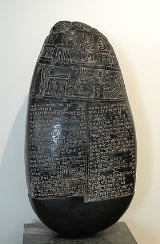
Kudurru
Encyclopedia

Land grant
A land grant is a gift of real estate – land or its privileges – made by a government or other authority as a reward for services to an individual, especially in return for military service...
s to vassal
Vassal
A vassal or feudatory is a person who has entered into a mutual obligation to a lord or monarch in the context of the feudal system in medieval Europe. The obligations often included military support and mutual protection, in exchange for certain privileges, usually including the grant of land held...
s by the Kassites
Kassites
The Kassites were an ancient Near Eastern people who gained control of Babylonia after the fall of the Old Babylonian Empire after ca. 1531 BC to ca. 1155 BC...
in ancient Babylonia
Babylonia
Babylonia was an ancient cultural region in central-southern Mesopotamia , with Babylon as its capital. Babylonia emerged as a major power when Hammurabi Babylonia was an ancient cultural region in central-southern Mesopotamia (present-day Iraq), with Babylon as its capital. Babylonia emerged as...
between the 16th and 12th centuries BCE. The word is Akkadian
Akkadian language
Akkadian is an extinct Semitic language that was spoken in ancient Mesopotamia. The earliest attested Semitic language, it used the cuneiform writing system derived ultimately from ancient Sumerian, an unrelated language isolate...
for "frontier" or "boundary" (cf. Hebrew גדר "gader", fence, boundary). The kudurrus are the only surviving artworks for the period of Kassite rule in Babylonia
Babylonia
Babylonia was an ancient cultural region in central-southern Mesopotamia , with Babylon as its capital. Babylonia emerged as a major power when Hammurabi Babylonia was an ancient cultural region in central-southern Mesopotamia (present-day Iraq), with Babylon as its capital. Babylonia emerged as...
with examples kept in the Louvre
Louvre
The Musée du Louvre – in English, the Louvre Museum or simply the Louvre – is one of the world's largest museums, the most visited art museum in the world and a historic monument. A central landmark of Paris, it is located on the Right Bank of the Seine in the 1st arrondissement...
and the National Museum of Iraq
National Museum of Iraq
The National Museum of Iraq is a museum located in Baghdad, Iraq. It contains precious relics from Mesopotamian civilization.-Foundation:...
.
The kudurrus recorded the land granted by the king to his vassals as a record of his decision. The original kudurru would be stored in a temple while the person granted the land would be given a clay copy to use as a boundary stone to confirm legal ownership.
The kudurrus would contain symbolic images of the gods who were protecting the contract, the contract itself and the divine curse that would be placed on a person who broke the contract. Some kudurrus also contained an image of the king who granted the land. As they contained a great deal of images as well as a contract, kudurrus were engraved on large slabs of stone.
See also
- Eanna-shum-iddina kudurruEanna-shum-iddina kudurruThe Eanna-shum-iddina kudurru is a boundary stone of governor Eanna-shum-iddina in the Sealand Dynasty of Babylon in the mid 2nd millennium BC...
- Kudurru for Ritti-MardukKudurru for Ritti-MardukThe Kudurru for Ritti-Marduk is a white limestone boundary stone of Nebuchadrezzar I, a king in the 4th Dynasty of Babylon, ca. the late 12th century BC. He is known to have made at least two kudurru boundary stones....
- Kudurru of GulaKudurru of GulaThe Kudurru of Gula is a boundary stone for the Babylonian goddess Gula. Gula is the goddess of healing. It is from the 14th century - 13th century BC Kassite Babylonia, and is located at the Louvre....
- Kudurru of MelishihuKudurru of MelishihuThe Kudurru of Melishihu is a grey limestone 0.7-meter tall boundary stone from ancient Babylonia, which is now housed at the Louvre.The obverse is composed of five iconographic registers, with representations of gods, humans and animals...
- Marduk-apal-iddina II kudurruMarduk-apal-iddina II kudurruThe Marduk-apal-iddina II kudurru is a boundary stone of Marduk-apal-iddina II, who ruled Babylon from 722 BC - 710 BC.Some kudurrus are known for their representations of the king, etc, who consigned the production...
- Marduk-nadin-ahhe kudurruMarduk-nadin-ahhe kudurruThe Marduk-nadin-ahhe kudurru is a black limestone boundary stone of Marduk-nadin-ahhe, who ruled ca. 1100 BC – 1082 BC in Dynasty IV of Babylon.Some kudurrus are known for their representations of the king, etc, who consigned it...
- Marduk-zakir-šumi I kudurruMarduk-zakir-šumi I kudurruThe Marduk-zakir-shumi I kudurru is a boundary stone of Marduk-zakir-šumi I, a king in the 10th dynasty of Babylon from 855 - 819 BC....
- Melišipak kudurru-Land grant to Marduk-apal-iddina IMelišipak kudurru-Land grant to Marduk-apal-iddina IThe Melishipak kudurru-Land grant to Marduk-apla-iddina I is a boundary stone of Melišipak, a Kassite ruler of Babylon ca. 1186–1172 BC . The land grant was made to his son, Marduk-apla-iddina I....
- Nazimaruttaš kudurru stoneNazimaruttaš kudurru stoneThe Nazimaruttash kudurru stone is a boundary stone of Nazimaruttaš, a Kassite king of Babylon, ca. 1307–1282 BC . It was found at Susa and is now displayed at the Louvre....

